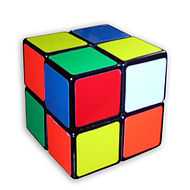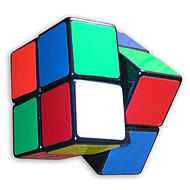Pocket Cube

The Pocket Cube (also known as the Mini Cube or the Ice Cube) is the 2×2×2 equivalent of a Rubik's Cube. The cube consists of 8 pieces, all corners.
Permutations



i. Solved pocket cube.
ii. Scrambled pocket cube.
iii.Pocket cube with one side tilted.
Any permutation of the eight corners is possible (8! positions), and seven of them can be independently rotated (37 positions). There is nothing identifying the orientation of the cube in space, reducing the positions by a factor of 24. This is because all 24 possible positions and orientations of the first corner are equivalent due to the lack of fixed centers. This factor does not appear when calculating the permutations of N×N×N cubes where N is odd, since those puzzles have fixed centers which identify the cube's spatial orientation. The number of possible positions of the cube is
The maximum number of turns required to solve the cube is up to 11 full turns, or up to 14 quarter turns.[1]
The number f of positions that require n full twists and number q of positions that require n quarter turn twists are:
| n | f | q |
|---|---|---|
| 0 | 1 | 1 |
| 1 | 9 | 6 |
| 2 | 54 | 27 |
| 3 | 321 | 120 |
| 4 | 1847 | 534 |
| 5 | 9992 | 2256 |
| 6 | 50136 | 8969 |
| 7 | 227536 | 33058 |
| 8 | 870072 | 114149 |
| 9 | 1887748 | 360508 |
| 10 | 623800 | 930588 |
| 11 | 2644 | 1350852 |
| 12 | 0 | 782536 |
| 13 | 0 | 90280 |
| 14 | 0 | 276 |
For the miniature (2 × 2 × 2) Rubik’s cube, the two-generator subgroup (the number of positions generated just by rotations of two adjacent faces) is of order 29,160. [2]
Records

Christian Kaserer holds the current world record of solving the Pocket Cube in competition, with a time of 0.69 seconds set at the Trentin Open 2011, using only four turns to solve the cube.[3][4] For the best average time of 5 solves, Christopher Olson holds the world record with a time of 1.71 seconds, which was set at Cubetcha 2013. His record was debated for a brief time, due to the possibility of an unfair inspection time. However, the World Cube Association decided to agree with delegate Bryan Logan, the judge of Chris's attempts, who allowed the solve to be completed and counted, granting Chris the world record. [5]
Variants
At Rubik's online store, an easier version of the Pocket Cube exists, dubbed the "Junior Cube". This version has only two colors, with a picture of a monkey on one face.
The Rubik's Ice Cube is a version of the Pocket Cube with transparent plastic and translucent stickers. It comes with a clear blue, ice-like display base.
The Eastsheen company produces a variation as well. It has a different turning mechanism and is noticeably larger (5 cm (2.0 in)) than the original.
Verdes Innovations has released the V-Cube 2, which is available in two shapes. The flat-sided V-Cube 2 is roughly the same size as the Eastsheen cube. The V-Cube 2b has a rounded shape like the V-Cube 7.
Another two common variations particularly in speedcubing is WitEden's Wittwo cube, and Shengshou's pocket cube. These cubes adopt an inner 3x3 core with smaller edges. These edges are hidden by the much larger corners which form the outside of the puzzle. This resembles the structure of the V-Cube 6, which has a similar design.
Methods
The most common beginner method is a layer-by-layer solution, similar to solving a 3x3. Popular methods among speedcubers are Ortega or Guimond, which orient both layers separately and permute them together, CLL, which solves the cube in one algorithm after the first layer is complete, and EG, which extends CLL with additional algorithms to solve the cube in one algorithm after one face is oriented.
See also
.gif)
- Pyramorphix, a pyramidal puzzle that uses the same mechanism
- Rubik's Cube (3×3×3)
- Rubik's Revenge (4×4×4)
- Professor's Cube (5×5×5)
- V-Cube 6 (6×6×6)
- V-Cube 7 (7×7×7)
- Speedcubing
- Combination puzzles
References
External resources
Information about methods for speedsolving the 2x2x2
| ||||||||||||||||||||||||||||||||||||||||||||||||||||||||||||
